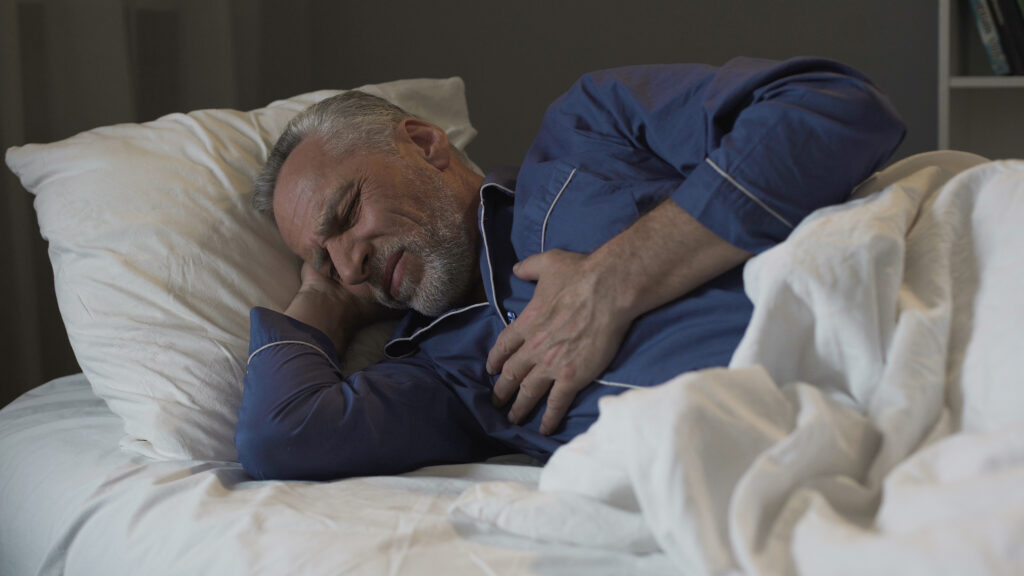
Central sleep apnea is common among patients with chronic heart failure with reduced left ventricular ejection fraction (HFrEF), affecting about a third of patients.1,2 Indeed, patients’ bed partners often observe frightening abnormal breathing events, reflecting Hunter-Cheyne-Stokes breathing. Over time, central sleep apnea contributes to the progression of heart failure through various mechanisms.3 New research by Javaheri et al. shows the burden of apneic episodes increases as the night progresses.4
The contributions of central sleep apnea to heart failure
The negative effects of central sleep apnea are similar in many ways to those of obstructive sleep apnea.3 Periods of central sleep apnea are characterized by a lack of airflow and respiratory effort as the drive to breathe from brainstem is reduced (as opposed to obstructive sleep apnea, in which a portion of the airway blocks airflow). Apnea leads to hypoxia, arousal with catecholamine release, and a period hyperventilation/hyperpnea with reoxygenation. Not only are these cyclical events disruptive to sleep, but they also contribute to endothelial dysfunction, vasoconstriction, platelet aggregation, and thrombosis. This cycle also causes smooth muscle cells to proliferate, leading to left ventricular hypertrophy. Inflammation alters contractility of the heart and causes adverse cardiac remodeling. Arousal-induced norepinephrine release also leads to adverse cardiac remodeling through myocyte hypertrophy and cell death in the heart. Blood pressure increases, and myocardial tissue oxygen demand increases, which further strains the heart and contributes to worsening heart failure and increased mortaility.1,3
OSA and CSA are worst at different times of the night
In patients with HFrEF who have both obstructive and central sleep apnea, obstructive sleep apnea events are most prominent at the beginning of sleep, and central sleep apnea events are most prominent at the end of sleep.5 As the night progresses, cardiac function appears to worsen as circulation time increases.5 Javaheri examined this phenomenon in 41 patients with HFrEF (LVEF <40%) with mostly CSA, i.e., patients who had moderate to severe CSA and minimal obstructive apneic events.4 The group found that, with the exception of the first cycle of non-rapid eye movement (NREM) sleep, NREM sleep is where most CSA events occur, the number and length of central apneic events increased throughout the night.4 The central apnea index was 21 ± 3 events/hr in NREM segment 2 and 37 ± 4 events/hr in NREM segment 8 (p = 0.001). The mean length of central event was 22 ± 1 sec in the first NREM segment and 26 ± 1 sec in the eighth NREM segment (p < 0.001). Interestingly, the hypopnea index, which indicates reduced or shallow airflow rather than breathing cessation, significantly decreased as the night progressed (p = 0.017).4 This finding suggests hypopneas convert to central apneas during the sleep period.
Arousals also worsen as the night goes on in HFrEF patients with CSA
Javaheri and coauthors also tracked the arousal index (number of arousals per hour of sleep) and found a significant change in arousals with time (p = 0.023). There was a trend for the respiratory arousal index to increase with time and as central apnea events worsened (p = 0.097). The authors note that statistical significance may have been limited because of the relatively small number of patients (n = 41).
Implications for cardiology practice
For reasons that are unclear, central sleep apnea is particularly common in patients with chronic heart failure. Accumulating reports are documenting the negative consequences of central sleep apnea on the course of heart failure, with apneic events contributing to that pathophysiology and mortality of heart failure itself. Heart failure patients should be screened for sleep apnea (obstructive and central). At-home sleep apnea testing provides a convenient and reliable method for diagnosing obstructive, central, and mixed sleep apneas. For example, the WatchPAT that includes the Central PLUS sensor not only detects changes in intra-thoracic pressure, but also includes a 3D accelerometer to detect snoring and body position. In a prospective, multi-center, multinational study, WatchPAT algorithms automatically distinguished CSA from OSA.6 These results compared favorably with manually scored polysomnography. In other words, WatchPAT with Central PLUS is able to accurately diagnose CSA, OSA, or mixed apneas from the comfort of a patient’s home. This technology provides cardiologists with a reliable and convenient method for detecting disease-worsening apneas in their chronic heart failure patients.
References
1. Oldenburg O, Wellmann B, Buchholz A, et al. Nocturnal hypoxaemia is associated with increased mortality in stable heart failure patients. Eur Heart J. 2016;37(21):1695-1703. 10.1093/eurheartj/ehv624
2. Javaheri S, Parker TJ, Liming JD, et al. Sleep apnea in 81 ambulatory male patients with stable heart failure. Types and their prevalences, consequences, and presentations. Circulation. 1998;97(21):2154-2159. 10.1161/01.cir.97.21.2154
3. Costanzo MR, Khayat R, Ponikowski P, et al. Mechanisms and clinical consequences of untreated central sleep apnea in heart failure. J Am Coll Cardiol. 2015;65(1):72-84. 10.1016/j.jacc.2014.10.025
4. Javaheri S, McKane SW, Cameron N, Germany RE, Malhotra A. In patients with heart failure the burden of central sleep apnea increases in the late sleep hours. Sleep. 2019;42(1). 10.1093/sleep/zsy195
5. Tkacova R, Niroumand M, Lorenzi-Filho G, Bradley TD. Overnight shift from obstructive to central apneas in patients with heart failure: role of PCO2 and circulatory delay. Circulation. 2001;103(2):238-243. 10.1161/01.cir.103.2.238
6. Pillar G, Berall M, Berry R, et al. Detecting central sleep apnea in adult patients using WatchPAT-a multicenter validation study. Sleep Breath. 2020;24(1):387-398. 10.1007/s11325-019-01904-5
